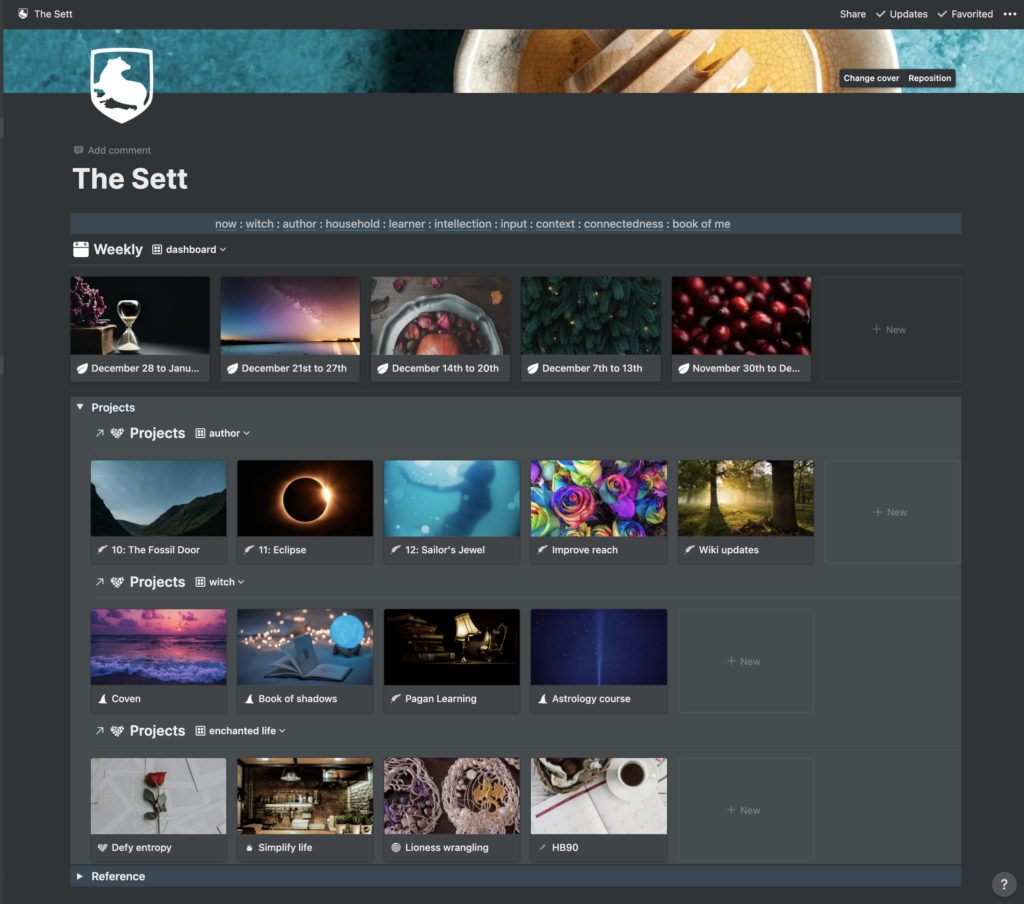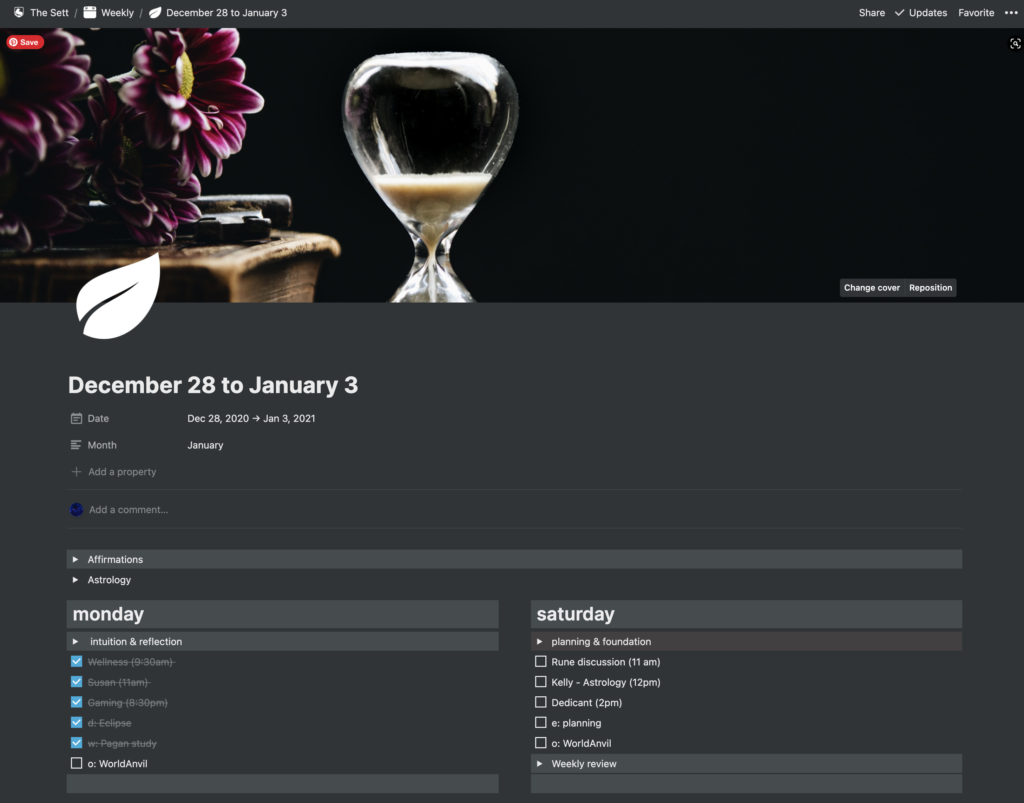Now we’re getting into the meat of how I get things done – where all the tasks live. I use a combo of Todoist, Centered, and Notion to do this.
Here are all the parts of the series if you want to jump around:
- Intro (an overview of what my goals are with this)
- Long-term planning (how I approach it)
- Doing things (task management)
- Tracking (keeping track of what I’ve done)
Todoist
All my actual tasks live in Todoist, in a series of projects based on the astrological planets, because I have found this is a handy mental sorting approach for my brain (I don’t really use Uranus and Neptune, though.)
This roughly sorts to “areas” of other people’s systems. Some of these get a lot more time than others, but by splitting them this way, I can see how the balance is going fairly easily.
- Sun: Professional life under my legal name
- Moon: Religion and magic (has a sub-project for coven)
- Mercury: Writing and writing-related tasks.
- Venus: Either doing pleasurable things (museums, concerts, etc.) or social time and connections.
- Mars: Where I stick urgent things to be done. (Now that I’m trying HB90, I’m going to try sticking projects in there and see how that works. Todoist has a new board feature.)
- Jupiter: Expansion – learning stuff, trying new things, prosperity work.
- Saturn: Planning and structure stuff.
- Pluto: Money management and legacy type things
Obviously all of these have sub-projects
I also have a project called “Watch” where I can stick links to stuff I want to watch eventually, by category. (I’m working on training myself to edit the length into the link name and/or tag the length, but that is a work in progress. I usually stick a priority on the ones I want to watch first so they rise to the top of the list.) For example, I have Watch – crafting, Watch – history, Watch – doing (productivity), Watch – magic, and so on. This is mostly a lot of YouTube videos.
I have the paid version of Todoist ($30 for a year), and consider that very worthwhile for being able to things with labels and being able to send emails from Gmail (or other email providers) to Todoist.
This absolutely saves me at work regularly, where I have stuff I need to revisit some time later, but don’t want to lose track of. (Ok, now we have the Snooze feature, that helps, but if I do it in Todoist, I can give it a useful label so I remember what I wanted to do with it. and add comments or files if I want to.)
Centered
Centered is the latest addition, as a way to get me to sit down and do sustained work. It’s a quite new app – they launched a hair before the pandemic.
Gorgeous photos, Pavlovian chimes to reward you for completing tasks are surprisingly helpful to me. It’s designed as a focus app (if you hit play on a task, it will mute notifications if you want it to, and nudge you when you are doing things it thinks aren’t related – you can train it, but it’s fairly accurate from the start.)
The real gap it fills for me is that you can put in tasks (or pull them from other things, including Todoist though in practice I just type in a quick title), and then you can move them around on the schedule of your day to figure out where they fit.
Mac only, $10 a month. I have some free passes to try it for a month (that refill every month) so if you’re intrigued, drop me a note in the contact form.
It works great when I use it. I do not always manage to use it.
Notion
Notion fills in the gap between “how to prioritise what I need to do on a given day” and “tracking what I’ve done”. It is an immensely flexible system that lets you drop in blocks that do things (which can be paragraphs of text, images, simple databases. All sorts of things.)
I keep three basic things in it. I navigate to them with a dashboard. Usually I have a tab with the dashboard open all the time, and one with my weekly page. Here’s the dashboard:

First, weekly pages where I can lay out stuff for that week and keep some handy lists (like my weekly planning checklist) all in one place, and have somewhere easily editable I can stash “here are the big things I want to do today.”
I set up a new page every week (running Monday to Sunday, and I do my planning for the week on Saturdays), which gets a pretty seasonal or otherwise thematic image.
I use a template with sections for each day (Monday to Friday on the left, Saturday and Sunday on the right.) Saturday has a toggle list with my ‘what are my steps in my weekly planning so I don’t forget one’. I put in meetings and appointments for each day (not as a calendar function, but so I can see when I do and don’t have blocks of time to work on other things.)

I also use it for notes for certain kinds of things, for lists of things (grocery shopping list planning, for example). The ability to add images for gallery (and some other) modes makes it very appealing to look at.
Finally, it’s the place I keep repeating task lists like “publish the next book” – things that have a bunch of steps, but are not always amenable to being tasks in Todoist (since some of them are “wait for the thing to go live, then do these three things…”)
Unless you want to collaborate with people, the free version should be fine here.
Trello
Between when I started writing this up and now, I’ve decided to put the HB90 projects/tasks into Trello as well. (The board implementation on Todoist is a little fiddly if you want to have a list of what you’ve completed.)
Mostly, I check this on Saturdays when I plan for the week, put specific tasks into Todoist from there, and get on with it.
Again, unless you need more collaboration or integration tools, the free version should be fine here.
- Intro (an overview of what my goals are with this)
- Long-term planning (how I approach it)
- Doing things (task management)
- Tracking (keeping track of what I’ve done)



